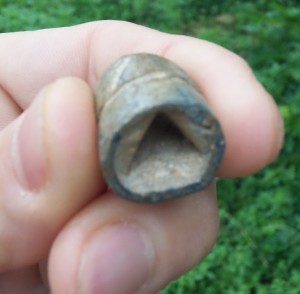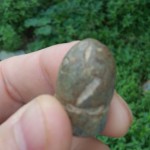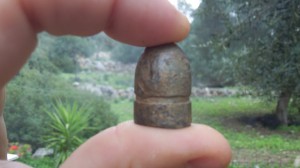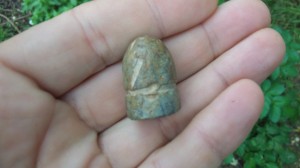A year or more ago, one of my kids came running in from the back garden full of excitement. “I’ve found a bullet, I’ve found a bullet!” he was shouting. Now, round here, that’s not as unusual as it sounds. There are plenty of 9mm casings and even the occasional spent round lying about the place. People tend to forget that blanks are better for celebrations.
But this was unusual. It was large and heavy. It was something….well….older.
As luck would have it, i happened to mention the bullet in conversation with Brian Payne, an ex-military man, who is living near Paleochora at the moment. His eyes lit up and asked if he could have a look at it and give me his expert opinion.
Brian took the bullet and, after making his own assumptions, decided to get some more from one or two ordinance experts he is in touch with in the UK. Now, they did not agree with each other 100% but, from what they told Brian and from what he already knew about the bullet, he was able to put together a detailed and very interesting report about it.
Brian has kindly allowed me to reproduce the report here. I have added a few photos I took today as well, in the garden where it was found.
Barry’s Bullet
A short report on a single expended lead bullet, found in a a garden, at Paleochora, Crete.
Calibre: Nominal 17mm. Equivalent to 0.670 inches – for these purposes, this round might be considered as a possible .670 calibre round. The round is deformed, by passage of time, and impacts from agriculture.
Weight: Nominal 46gm. [c. 700 grain] The round has both been ablated by erosion and has been struck by agricultural implements. 700 grain is a very heavy bullet weight.
Composition: Lead, untested. Weight is consistent with pure lead.
Description: A round nosed bullet, of simple design. The nose of the bullet has been deformed by two post-firing impacts. The shape of the bullet is consistent with late C.19th manufacture. The bullet is 25mm in height. The curve of the nose starts at 12mm from the base of the bullet. Between 7 and 9mm from the base of the bullet, there is a 1mm deep crimp mark, indicating that the bullet was manufactured as part of a fixed round – it had a cartridge case. There is a discernible mould mark on the external surface of the round indicating that the round was moulded in a two part mould. That is confirmed by the clearly shaped triangular cone impression within the base of the bullet, extending 9mm into the body of the bullet. The bullet has been repeatedly struck by other objects, but all are post-flight.
 Conclusions:
Conclusions:
1. This is a fired round – there are 3 clear land marks on half of the circumference of the body of the bullet.
2. The bullet was commercially manufactured.
3. The bullet was crimped to a cartridge case.
4. The bullet is an expended round – it has been fired and has fallen to earth. There is no impact deformation, nor target butt splatter.
Discussion:
This bullet has sparked some debate between parties. I emailed images to three friends, each of whom came up with a different view. All are experts in their field of black powder and pre-20th Century firearms.
The consensus is as follows:
The bullet was fired from a weapon that had a very low twist rate in the rifling. The marks on the bullet from the rifling in the barrel of the weapon – the 3 observable land marks – are at a low angle of incidence, indicating that either the weapon that fired the round was a very long barrelled rifle, or it was a handgun intended for very short range. The likelihood is that there were 7 lands in the barrel at a 1:48 twist rate. This was a low velocity weapon, relying on the inertial mass of the bullet to give it stability in flight.
The single crimp mark on the bullet is significant. It places the bullet at a later date than the Minie bullet shape of the mid 19th Century. The rifle bullets of that period have a triple crimp mark. On the balance of probability, the single crimp places the round as having been fixed to a brass cartridge case. It precludes the round as having been muzzle loaded.
The calibre of the weapon, however, places the weapon at the early part of the 19th Century. The weight of the bullet and the calibre preclude a pistol. Putting it simply, the recoil from the weapon would have rendered it extremely inaccurate. The calibre is equivalent to the common calibre of muskets in use from the late 18th Century onwards. Therefore, it is probable that the bullet was fired by a rifled musket, or musket conversion.
Very substantial numbers of rifled muskets were converted from muzzle loading to breech loading during the 19th Century. The British sold some 250,000 Tower muskets in the early part of the century, and conversions of these were still coming to light in the 1930s. The American Civil War, and numerous other wars of independence worldwide hoovered up muskets for conversion. It is probable that the bullet found was fired by a musket converted to fire a cartridge round.

We cannot say what make of rifle/musket fired this bullet. Please note that musket conversions only have a nominal calibre – the bore diameter was remarkably inconsistent, even within the length of a single barrel. If you could get it to go up the barrel, you fired it! The mass of the bullet overcame the inaccuracy caused by poor fit between the bullet and the barrel.
Brian Payne is a specialist in UK Firearms Law. Please visit and support Help For Heroes




Recent Comments